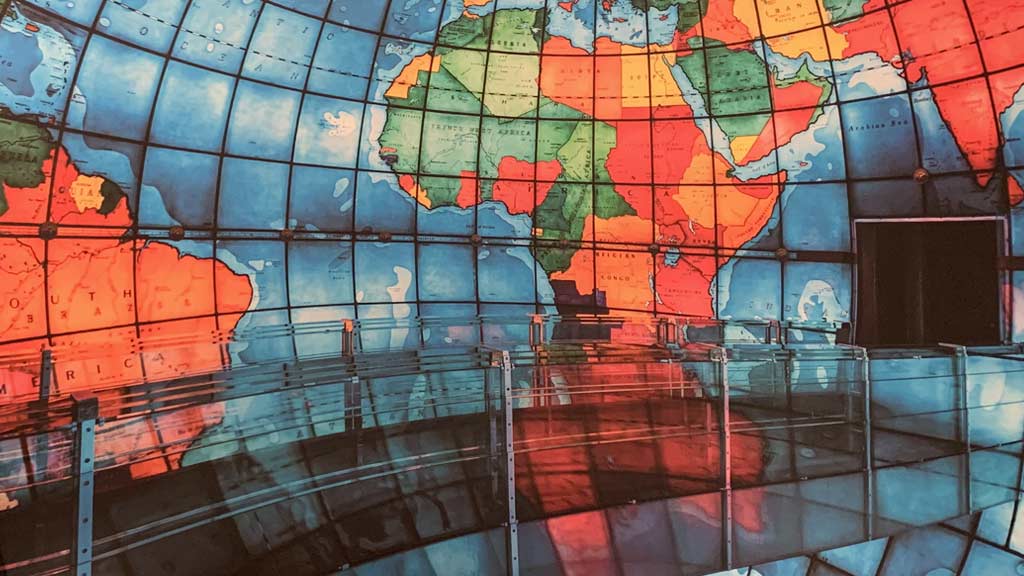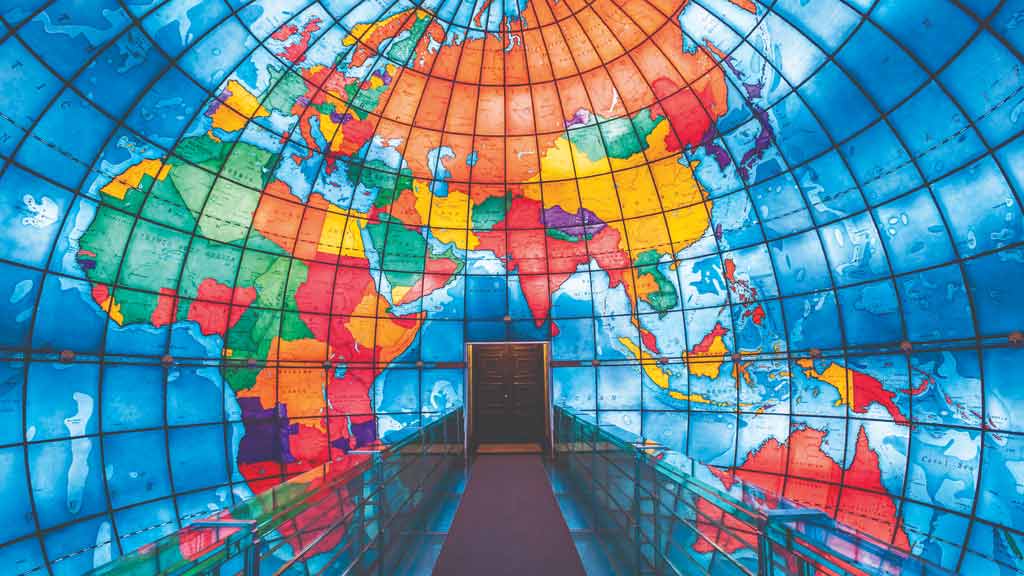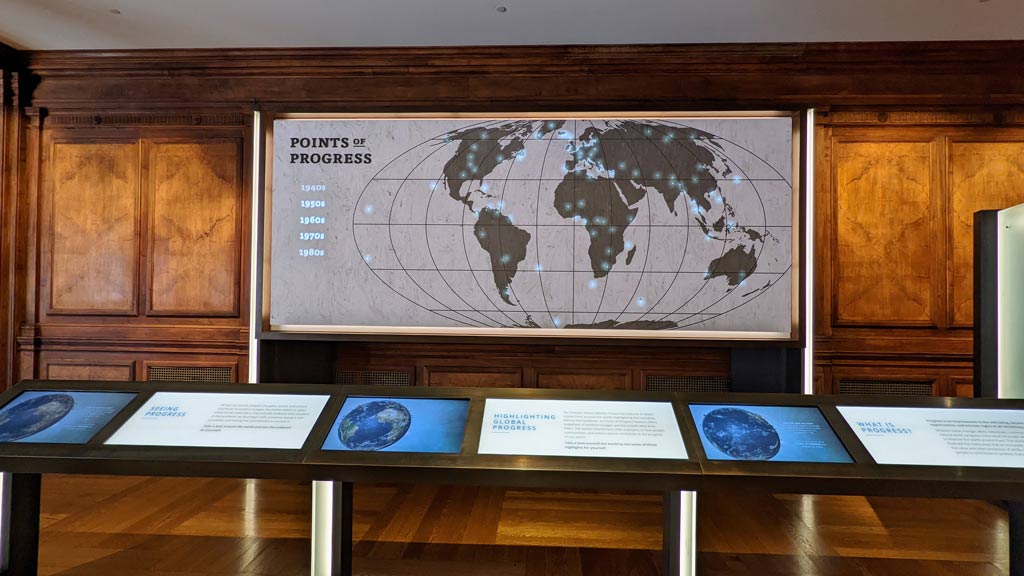Nestled within the vivid city of Boston, the Mapparium stands as a beacon of architectural brilliance and educational enlightenment.
This unparalleled attraction, housed within the Mary Baker Eddy Library, offers visitors a captivating journey through time and space.
With its striking spherical design comprised of 608 stained-glass panels, the Mapparium presents a unique opportunity to explore the geopolitical landscape of the 1930s.
As visitors traverse the narrow bridge spanning its diameter, they are enveloped by a kaleidoscope of colors and immersed in a world of historical significance.
Beyond its aesthetic appeal, the Mapparium serves as an invaluable educational resource, providing insights into geography, history, and geopolitics.
As a cultural landmark and symbol of innovation, the Mapparium invites visitors to embark on a transformative experience that transcends traditional boundaries and inspires curiosity and wonder.
Mapparium Boston
The Mapparium, located in Boston, Massachusetts, is a unique architectural wonder and an immersive experience that offers visitors a journey through time and space.
Situated within the Mary Baker Eddy Library, the Mapparium is a three-story, stained-glass globe that provides a fascinating perspective on the world’s geopolitical landscape.
History and Architecture

The Mapparium was designed by architect Chester Lindsay Churchill and was completed in 1935.
Its creation was part of the Christian Science Publishing Society’s expansion project, which aimed to provide a space for its expanding operations and also to serve as a cultural and educational center.
The Mapparium’s spherical design was innovative for its time, and it remains one of the largest stained-glass globes in the world.
The structure consists of 608 stained-glass panels arranged to form a hollow globe with a diameter of 30 feet (9 meters).
Visitors enter the globe through a narrow bridge that traverses its diameter, providing a unique vantage point from which to view the intricate details of the world map depicted on the glass panels.
The map itself is a representation of the world as it was in 1935, providing a snapshot of geopolitical boundaries and territories from that era.
Immersive Experience

Stepping inside the Mapparium is akin to entering a time machine, transporting visitors back to the geopolitical landscape of the 1930s.
The curved glass panels envelop visitors in a kaleidoscope of colors, with each panel representing a different region of the world.
As visitors walk through the bridge, they are surrounded by the map’s intricate details, which are illuminated by an intricate system of lights positioned behind the glass panels.
The immersive experience is enhanced by a carefully orchestrated audiovisual presentation that accompanies the journey through the Mapparium.
Visitors are treated to a narration that provides historical context and insights into the geopolitical events of the era.
The combination of stunning visuals and informative narration creates a captivating experience that appeals to visitors of all ages.
Educational Value

Beyond its aesthetic appeal, the Mapparium serves as an invaluable educational resource, offering visitors a unique opportunity to learn about geography, history, and geopolitics.
The map’s depiction of the world in the 1930s provides a historical lens through which visitors can explore the geopolitical dynamics of that time period.
From the shifting boundaries of empires to the emergence of new nations, the Mapparium offers a comprehensive overview of the global landscape in the pre-World War II era.
Moreover, the Mapparium’s interactive nature encourages active engagement with its subject matter.
Visitors can trace the paths of historical events, identify key geopolitical landmarks, and gain a deeper understanding of the forces that have shaped the modern world.
Whether for school groups, tourists, or curious individuals, the Mapparium offers a rich educational experience that transcends traditional classroom learning.
Cultural Significance

In addition to its educational value, the Mapparium holds significant cultural importance as a symbol of innovation and human ingenuity.
Its construction represented a feat of engineering and craftsmanship, showcasing the capabilities of the architects and artisans involved in its creation.
The Mapparium’s timeless design continues to inspire awe and wonder, attracting visitors from around the world to marvel at its beauty and historical significance.
Furthermore, the Mapparium serves as a testament to the enduring legacy of the Christian Science Publishing Society and its commitment to promoting cultural understanding and global awareness.
By providing a space for dialogue and exploration, the Mapparium fosters connections across borders and encourages visitors to engage with diverse perspectives and ideas.
Visitor Experience
For visitors to the Mapparium, the experience is both visually stunning and intellectually stimulating.
As they traverse the bridge that spans the globe’s diameter, they are enveloped by the vivid colors and intricate details of the stained-glass panels.
The sensation of walking through the heart of the world offers a unique perspective on the interconnectedness of global geography and human history.
Throughout the journey, visitors are accompanied by a soundtrack that enhances the immersive experience, transporting them to distant lands and historical epochs.
The narration provides context and insights into the geopolitical events depicted on the map, enriching visitors’ understanding of the world and its complexities.
FAQs
What is the Mapparium in Boston?
The Mapparium is a unique architectural marvel located in Boston, Massachusetts.
It is a three-story, stained-glass globe housed within the Mary Baker Eddy Library, offering visitors an immersive journey through a 1930s world map.
How was the Mapparium constructed?
Designed by architect Chester Lindsay Churchill, the Mapparium was completed in 1935. It consists of 608 stained-glass panels arranged to form a hollow globe with a diameter of 30 feet (9 meters).
What can visitors expect during their visit to the Mapparium?
Visitors can expect a visually stunning and intellectually stimulating experience as they traverse a narrow bridge that spans the globe’s diameter.
They are surrounded by vivid colors and intricate details, while an audiovisual presentation provides historical context and insights into the geopolitical landscape of the 1930s.
Is the Mapparium educational?
Yes, the Mapparium serves as an invaluable educational resource, offering insights into geography, history, and geopolitics.
How long does it take to visit the Mapparium?
A typical visit to the Mapparium takes approximately 15 to 30 minutes, allowing visitors ample time to explore the immersive experience and engage with the accompanying audiovisual presentation.
Wrap Up
The Mapparium in Boston stands as a testament to human ingenuity and the power of education and cultural understanding.
Through its innovative design and immersive experience, it offers visitors a unique opportunity to explore the world of the past while gaining insights into the complexities of our global landscape.
As a symbol of architectural brilliance and historical significance, the Mapparium continues to inspire awe and wonder in all who have the privilege of experiencing it.
Its enduring legacy as a cultural landmark and educational resource underscores its importance in fostering connections across borders and promoting dialogue and exploration.
Whether you’re a student, a tourist, or a lifelong learner, the Mapparium invites you to embark on a journey of discovery that transcends time and space.
Laura Chassaigne